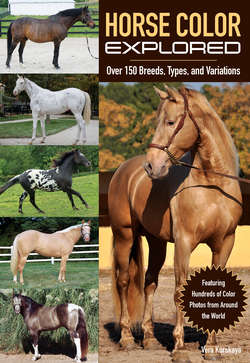Читать книгу Horse Economics - Vera Kurskaya - Страница 20
На сайте Литреса книга снята с продажи.
BAY
ОглавлениеBay horses have red or brown color of the trunk, and parts of the head, legs, mane, and tail are black (Photos 3–7). The tips of the ears and outer rims are also black. The skin and hooves are pigmented, eyes hazel, and eyelashes dark brown. The separation of the shades of bay is sometimes difficult and very subjective.
A light bay horse has light brown body hair. It is encountered rarely, and may be difficult to visually distinguish from buckskin (see p. 17). Dapples are observed in such horses more frequently than in the usual bay.
A bay horse with a dark or almost black torso is called dark bay. Dark brown and black hairs are mixed on the torso, and the brightest are concentrated above the nostrils, around the eyes, into groin, on the stomach, on the upper inside of the legs, and on the torso near the elbows. Let me emphasize that the expression “brightest” in this context is relative—in the case of dark bays it can be brown or dark brown, as long as it is “brighter” than the hair on the trunk. This color is characterized by dapples and can be confused with faded black (see p. 11). The two can be distinguished by the color of hair around the eyes: in the black horse, it will be black, while in the dark bay there is a brown or reddish ring in this place.
Bay without countershading, with a saturated reddish tone of body hair, is called red bay. This color is fairly rare. Bay with an expressed golden gloss of body hair is called golden bay. It occurs in the Akhal-Teke breed, and less frequently in Budyonny and Karabakh horses.
Sometimes you may encounter the so-called “Wild” bay color. On this horse the zone of black hair on the legs is restricted to the lower part, below the hocks and knees (Photo 8).
Bay foals have a red or light brown trunk and pale, almost white legs, with hardly noticeable dark hair below the hocks and knees. These areas become dark with age. The underbelly of a bay foal is also whitish.
Bay is the most common color in the world and is inherent to the majority of breeds. Some where it is found frequently include: the Arabian, Thoroughbred, Shire, Clydesdale, Paso Fino, Peruvian Paso, Kabardin, German Sport Horse, Latvian Horse, Vladimir Heavy Draft, French Trotter, and it is characteristic of the Cleveland Bay.
